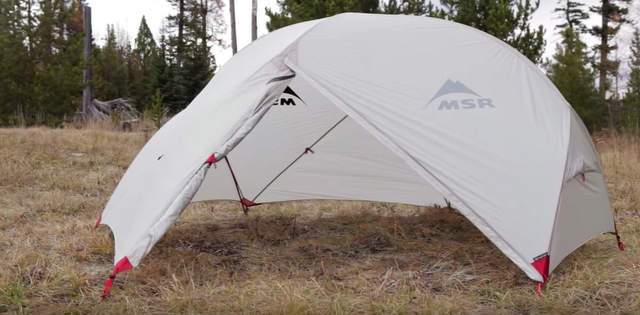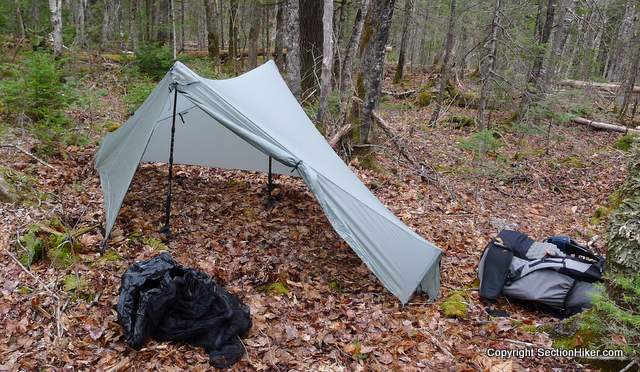
"You need to buy the tent footprint if you want the fast pitch option," is the common refrain of tent manufacturers and retailers. But you wonder, "When would I use the fast pitch option and what am I giving up if I don't buy the footprint now?"
Many double-wall tent manufacturers promote a fast fly or fast pitch option which lets you set up the rain fly with a footprint instead of the inner mesh tent as a weight saving option, when you don't need the insect protection or creepy-crawly protection (spiders, scorpions, and snakes) it provides. The inner tents on most lightweight 2-person double-wall tents weigh close to 16 ounces, so this can save you a serious amount of gear weight in the right circumstances.
For example on the Big Agnes Fly Creek (shown above), you'd stake down the footprint, open and insert the multi-segment pole tips into the footprint's corner grommets, and then drape your rain fly over the poles and connecting it to the footprint's corner connectors. For added strength, you can wrap the velcro connectors on the underside of the rain fly to the poles. While the resulting structure isn't as sturdy, windproof, or rain-proof as it is when using the inner tent, it provides a tarp-like structure that provides light weather protection for well protected campsites.
When would you use a fast pitch option like this? You could use it for short backpacking trips where you're confident of favorable weather or anyplace where you might cowboy camp, but still want a lightweight shelter for just-in-case morning dew or light rain protection. You can also use it as a sun shade if you're hiking in the desert. The good thing about the fast pitch option is that you don't need trees or trekking poles to set it up, like a tarp.
- No trees or trekking poles required to pitch rain fly
- No extra long guylines or knot knowledge required like a tarp
- Makes a good sun shelter when shade is unavailable
- Provide protection against heavy dew and light drizzle
- Provides increased privacy over most tarp setups
Despite these advantages, fast fly options that require a footprint are fairly limited. While they do provide limited protection in light rain, there's usually a substantial gap between the footprint and the bottom edge of the rain fly that lets let wind-blown rain enter the tent or drip on to the footprint. They also provide little protection from wind-blown sand, dust, or snow.

Fast Pitch Options that Don't Require Footprints
Some tents don't require the purchase of footprint to set up the rainfly. For example, the MSR Hubba Hubba NX rain fly can be set up without a footprint, although you also have the option of purchasing a footprint and setting it up with one if you want the added benefit of a groundsheet. The problem with these footprint-free setups is that they tend to be structurally weaker than footprint-based fast fly pitches, because the only thing supporting them are tent stakes. Still they are less expensive than footprint-based fast fly pitches because you don't have the added cost of a tent footprint.
Fast and Light Tent Bodies
MSR also offers a new fast and light tent body (see the SectionHiker Review) that is an inner tent without the insect netting and overcomes the structural deficiencies of footprint-based fast fly options. It also solves the issue of rain splatter and drips onto the footprint floor suffered by fast fly options that require footprints. They're heavy though and represent little weight savings compared to using a footprint-based solution. They also cost a lot more than a footprint.
Fly First Tents
There are also tents available that let you pitch the rain fly first, before you set up the inner tent. Once the rain fly is set up, you can crawl underneath it to get out of the weather and hang the inner tent by hooks suspended from the rain fly's ceiling. This is a pretty common option in European-made double-wall tents from companies like Hilleberg. Tarptent also sells many tents with this capability.

The main benefit of a fly-first pitch is the ability to set the tent up in the rain without getting the inner tent wet. Some of these fly-first tent pitches are also quite structurally strong, particularly those where the poles slot into sleeves sewn to the rain fly instead of being connected using velcro strips.
Popular tents that fall into this category include:
Wrap Up
I've illustrated a number of different approaches that tent manufacturers offer for setting up a rain fly without requiring an inner tent:
- Footprint-based fast fly options
- Footprint-free fast fly options
- Fast and light tent bodies
- Fly-first tents
In terms of value, the best option for using a rain fly alone is to purchase what I've called a fly-first tent, where the rain fly can be set up by itself or before the inner tent. These tend to be strong and weather worthy, even when the rain fly is used alone. While they can be expensive, you get two fully functional tents for the price of one, when used with or without the inner tent.
While MSR's new fast and light tent bodies solve the structural inadequacies of footprint-based and footprint-free fast fly options, they provide very little weight savings for the cost.
Footprint-based fast fly options provide the least value however because they're so limited by location or the time of year (insect-free) when you can use them. While buying a footprint that matches your tent can make sense if you camp on abrasive ground and have a very thin tent floor, it doesn't make sense to buy a tent footprint so you can use a tent's footprint-based fast fly option.
SectionHiker.com receives affiliate compensation from retailers that we link to if you make a purchase through them, at no additional cost to you. This helps to keep our content free and pays for our website hosting costs. Thank you for your support.The post Backpacking Tent Fast Pitch Options: Pros and Cons appeared first on Section Hikers Backpacking Blog.
from Section Hikers Backpacking Blog https://ift.tt/2MZcyoF
No comments:
Post a Comment